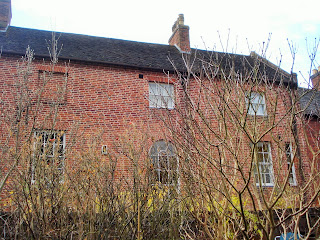 |
| A spectacular view of Lichfield Cathedral from a window at Erasmus Darwin House - imagine enjoying that view ever day! |
And, since people outside Lichfield never seem to have heard of Erasmus, I thought I’d share some photos on Saturday Snapshot, because he’s a fascinating character who really does deserve a wider audience. And today seemed a good time, because Thursday (December 12) was the anniversary of his birth in 1731, and there are all sorts of activities going on there all weekend.
 |
| A portrait of Erasmus Darwin, taken off the Erasmus Darwin Foundation website. |
He
was a newly qualified physician when he moved to Lichfield in 1756, aged just
25, and quickly became renowned for his ideas and skills. George III asked him to be the Royal Physician, but Erasmus turned the offer down, preferring to remain independent.
He was a leading
member of the Lunar Society, a group of Midlands-based friends, whose work gained
them national acclaim and helped power the industrial revolution. The circle
included James Watt (the steam engine man) and pottery manufacturer Josiah
Wedgwood, and the informal club (a kind of ‘think-tank’ I guess) gathered once
a month, when the moon was full, so they could see their way home! And they
called themselves ‘lunaticks’! Anyway,
Darwin and his wife bought an old Medieval house, and he promptly embarked on
an improvement scheme, enlarging it and building a stylish new frontage looking
out on to Beacon Street. I believe the correct term for it is Palladian, but I
always say Georgian – all symmetrical, with steps and big windows.
The
back part of the house remained unchanged, and is less imposing, but much
nicer, and this is where the entrance used by visitors. You reach it along a little
alley from The Close (the area around the Cathedral –I’ll put up some more
pictures from around there another day, because it really is very beautiful,
and very historic).
The
little gardens have been planted out into areas with sweet-smelling medicinal
and culinary herbs, and are absolutely glorious in the summer. On a nice day you
can sit there with a good book, soaking up the sunshine and inhaling the fragrant
air, and it’s absolutely idyllic.
 |
| Darwin House: The posh front entrance! The white, ghostly shape in the top, left-hand window, is a model of Erasmus. |
 |
| Steps up to the door - I'll bet it it seemed a long, steep climb after a night out with the 'Lunatiks'. |
 |
| This is my Daughter in the alley which runs along the back of historic old houses and leads to Erasmus Darwin House. |
 |
| At the moment the garden is a shadow of what it is like in summer. |
 |
| The back door - in the window you can see the reflection of one of the Cathedral spires |
 |
| A view of the upper stories at the back - from these windows you can see the Cathedral. |
 |
| The model of a speaking machine created by Erasmus.The bellows at the bottom represent the lungs, and there are holes for the mouth and nose. |
.JPG) |
| Erasmus highlighted many of the medical, environmental and scientific issues which are still being discussed today. |
.JPG) |
| 'Erasmus Darwin' at his writing desk. |
 |
| Daughter and Friend... Emily, peering through a window alongside a figure of Erasmus. |
 |
| A spectacular mechanical bird designed by Erasmus. |







































